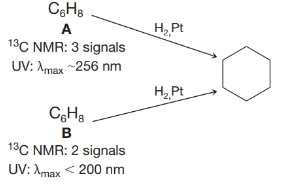
Concept explainers
Practice Problem 13.7
Two compounds, A and B, have the same molecular formula,

Trending nowThis is a popular solution!

Chapter 13 Solutions
Organic Chemistry
Additional Science Textbook Solutions
General Chemistry: Atoms First
Living By Chemistry: First Edition Textbook
Introductory Chemistry (5th Edition) (Standalone Book)
Chemistry: Structure and Properties
CHEMISTRY-TEXT
The Organic Chem Lab Survival Manual: A Student's Guide to Techniques
- You have a sample of a compound of molecular formula C11H15NO2, which has a benzene ring substituted by two groups, (CH3)2N− and −CO2CH2CH3, and exhibits the given 13C NMR. What disubstituted benzene isomer corresponds to these 13C data?arrow_forwardA bottle is labeled only "Compound B (C6H₁2)" and contains a colorless liquid. You have been called in as an expert to identify this compound from its spectra: IR: 3080, 1646, 888 cm¯¹; ¹H NMR 2400 2100 8 1800 compound B (C6H₁2) 7 1500 6 M chemical shift, Hz 1200 5 4695 900 J = 6.9 Hz 600 2234 6721 3 4 chemical shift, ppm (8) The magenta numbers in the spectrum are the relative integrals in arbitrary units, and the violet numbers are coupling constants. 300 13730 2 0 1 J = 6.9 Hz 0arrow_forwardTreatment of 2-methylpropanenitrile [(CH3)2CHCN] withCH3CH2CH2MgBr, followed by aqueous acid, affords compound V, whichhas molecular formula C7H14O. V has a strong absorption in its IRspectrum at 1713 cm−1, and gives the following 1H NMR data: 0.91(triplet, 3 H), 1.09 (doublet, 6 H), 1.6 (multiplet, 2 H), 2.43 (triplet, 2 H), and2.60 (septet, 1 H) ppm. What is the structure of V?arrow_forward
- Compound A has molecular formula C8H18. It shows one singlet in the ¹H-NMR spectrum. Identify A and explain your reasoning. For the toolbar, press ALT+F10 (PC) or ALT+FN+F10 (Mac). BIUS Paragraph V Arial = = = = +8HE {} X² X₂ PR хо 23 V 10pt >¶ ¶< - ABC :3 v V ✓ Ev AV ¶T "Ω Θ I 用く x B Q ► 8. Earrow_forwardThe 'H NMR spectrum of compound A (C3H100) has four signals: a multiplet at 8 = 7.25-7.32 ppm (5 H), a singlet at d = 5.17 ppm (1 H), a quartet at d = 4.98 ppm (1 H), and a doublet at ô = 1.49 ppm (3 H). There are 6 signals in its 13C NMR spectrum. The IR spectrum has a broad absorption in the -3200 cm-1 region. Compound A reacts with KMNO4 in a basic solution followed by acidification to give compound B with the molecular formula C7H6O2. Draw structures for compounds A and B.arrow_forwardThe 1H NMR spectrum, 13C NMR spectrum, mass spectrum, and IR spectrum below belong to a chemical with the molecular formula C7H16O. Provide a structure for that compound. You must explain how you determined the structurearrow_forward
- O2N 1 3 7H 6 4 HO 6 8 A Predict the number of signals in the 13C NMR spectrum. Provide a rough sketch of the 13C NMR spectrum of compound A.arrow_forwardProvide the structure of three compounds with the molecular formula C4H,O that give an absorption peak at 1600-1640 cm¹ in the infrared spectrum, but no significant peaks at 3000-3600 cm²¹ or at 1650-1750 cm-¹.arrow_forwardIdentify A and B, isomers of molecular formula C3H4Cl2, from the given 1H NMR data: Compound A exhibits peaks at 1.75 (doublet, 3 H, J = 6.9 Hz) and 5.89 (quartet, 1 H, J = 6.9 Hz) ppm. Compound B exhibits peaks at 4.16 (singlet, 2 H), 5.42 (doublet, 1 H, J = 1.9 Hz), and 5.59 (doublet, 1 H, J = 1.9 Hz) ppm.arrow_forward
- Reaction of butanenitrile (CH3CH2CH2CN) with methylmagnesium bromide (CH3MgBr), followed by treatment with aqueous acid, forms compound G. G has a molecular ion in its mass spectrum at m/z = 86 and a base peak at m/z = 43. G exhibits a strong absorption in its IR spectrum at 1721 cm−1 and has the 1H NMR spectrum given below. What is the structure of G?arrow_forwardIdentify A and B, isomers of molecular formula C3H4Cl2, from the given 1H NMR data: Compound AJ = 6.9 Hz) and 5.89 (quartet, 1 H, J = 6.9 Hz) ppm. Compound B exhibits signals at 4.16 (singlet, 2 H), 5.42 (doublet, 1 H, J = 1.9 Hz), and 5.59 (doublet, 1 H, J = 1.9 Hz) ppm.arrow_forwardThe 1H-NMR spectrum of compound B,C7H14O , consists of the following signals: δ 0.9 (t, 6H), 1.6 (sextet, 4H), and 2.4 (t, 4H). Draw the structural formula of compound B.arrow_forward
 ChemistryChemistryISBN:9781305957404Author:Steven S. Zumdahl, Susan A. Zumdahl, Donald J. DeCostePublisher:Cengage Learning
ChemistryChemistryISBN:9781305957404Author:Steven S. Zumdahl, Susan A. Zumdahl, Donald J. DeCostePublisher:Cengage Learning ChemistryChemistryISBN:9781259911156Author:Raymond Chang Dr., Jason Overby ProfessorPublisher:McGraw-Hill Education
ChemistryChemistryISBN:9781259911156Author:Raymond Chang Dr., Jason Overby ProfessorPublisher:McGraw-Hill Education Principles of Instrumental AnalysisChemistryISBN:9781305577213Author:Douglas A. Skoog, F. James Holler, Stanley R. CrouchPublisher:Cengage Learning
Principles of Instrumental AnalysisChemistryISBN:9781305577213Author:Douglas A. Skoog, F. James Holler, Stanley R. CrouchPublisher:Cengage Learning Organic ChemistryChemistryISBN:9780078021558Author:Janice Gorzynski Smith Dr.Publisher:McGraw-Hill Education
Organic ChemistryChemistryISBN:9780078021558Author:Janice Gorzynski Smith Dr.Publisher:McGraw-Hill Education Chemistry: Principles and ReactionsChemistryISBN:9781305079373Author:William L. Masterton, Cecile N. HurleyPublisher:Cengage Learning
Chemistry: Principles and ReactionsChemistryISBN:9781305079373Author:William L. Masterton, Cecile N. HurleyPublisher:Cengage Learning Elementary Principles of Chemical Processes, Bind...ChemistryISBN:9781118431221Author:Richard M. Felder, Ronald W. Rousseau, Lisa G. BullardPublisher:WILEY
Elementary Principles of Chemical Processes, Bind...ChemistryISBN:9781118431221Author:Richard M. Felder, Ronald W. Rousseau, Lisa G. BullardPublisher:WILEY





